As a teacher educator who researches and supports young children’s mathematical learning, I meet teachers in preschool classrooms, college courses, and professional development workshops and presentations. I frequently hear a common refrain: “I’m just not good at math.” I often think, if they only knew.
You see, I’ve got a confession of sorts.
Math Avoidance
I remember long, long ago feeling wonderful about math. Unfortunately, that feeling lasted only until second grade. Then, I began to struggle. In fifth grade, I remember thinking that fractions and negative numbers were the same thing (after all, one-half was less than one and negative numbers were also less than one, right?).
By the time I took geometry in high school I was looking for a way out. I did well in all of my other subjects—I especially loved reading. But whenever I engaged in math problems, I felt like there was a fog in my head. Geometry was the last math class I would take in high school.
Then came college. Actually, many colleges—three community colleges and four state universities (but that’s another story for another time!). I managed to escape taking any math courses until I returned to school many years later to complete my bachelor’s degree in child and adolescent development. By that point, somebody had raised the ante, and I was forced to take math as a graduation requirement.
Back to Basics
I dreaded it—just thinking about math made my heart pound. I felt that I had missed fundamental math concepts throughout my education. But I knew that in order to finish my degree, I would need to pass a math class. So the summer before I went back to school at the local community college, I bought an inexpensive piece of computer software with workbooks that provided math problems and guidance beginning at the kindergarten level (at the cash register, I contemplated fibbing and saying I was buying it for another student).
I did every problem. When I ran into difficulties, I asked my daughter, who was in high school, to explain, which was more than a little humbling (although, bless her heart, she was really patient!). Before the fall semester started, I had to take a math placement test. Although I felt confident about the math that I had learned over the summer, the placement test made me anxious. I chose to take the lowest-level test and was placed in a non-unit-bearing math course (I was thrilled they didn’t send me back to third grade!). Again, I did every problem and paid close attention in class. It wasn’t as if I were a math whiz—I had a short disagreement with the instructor about rounding before realizing that I had misunderstood the entire concept—but math started to make sense. I would even say that I started to see a kind of beauty in algebra (don’t laugh—it’s true!). Everything in the equations balanced in a cool sort of way. I finished with one of the highest grades in the class (back when they posted such things for everyone to see).
The only problem with non-unit-bearing classes? They don’t count toward graduation. Which meant that now I had to take a math class that would count. I enrolled in a statistics class, did every problem, and paid close attention in class. By now, you have probably ascertained a pattern. Math takes engagement.
What I was also coming to realize was that I wasn’t bad at math. After passing that statistics course, I was able to enroll in a state university to complete the last two years of my bachelor’s degree. I took another statistics class. I’d like to say that was a choice, but it was actually a requirement. I made it to graduation.
Unexpected Career Path
After spending 14 years teaching young children, I now wanted to teach teachers—and that would require another degree. I was accepted into the master’s and PhD program in education at University of California, Berkeley. Again, I would be required to complete a statistics course. But, by now, I kind of liked statistics. Above all, I discovered it was useful in answering some important questions about education. Imagine my surprise when I was offered a graduate research position to study a large-scale intervention in early math. Children are amazing mathematicians when given the opportunity and support.
Right after my PhD graduation, I was offered an opportunity to work with a team of well-known researchers to create a developmentally appropriate oral assessment for primary grades 1-3 in low- and middle-income countries. The Early Grades Mathematics Assessment measures essential early math knowledge and skills and has been used in over 30 countries.
Now, exactly 20 summers after I returned to school, I spend much of my time thinking about math.
I have had amazing opportunities to work across the globe helping to make math meaningful to young children and teachers. I’ve worked with the United Nations Children’s Fund (UNICEF); United States Agency for International Development (USAID); World Health Organization (WHO); World Bank; and quite a few ministries of education on early math.
I’ve had the good fortune to team up with the DREME Network, where we think and talk about early math 24/7.
And, I must confess, I’m good at math.



